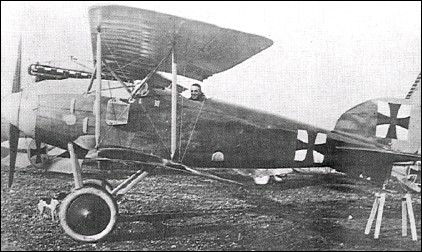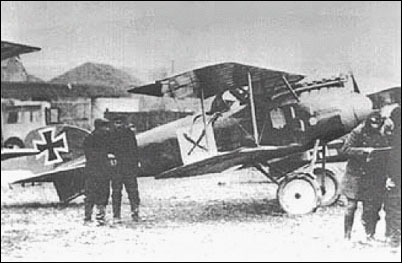|
| One of the most serious design faults of the D.I was the
poor forward and upward fields of vision provided for
the pilot, and to rectify this deficiency the upper wing
was lowered and the wing cellule was staggered, reducing
overall height by 36cm. With this and
other more minor changes, the fighter was redesignated
D.II, and an initial production batch of 100 was
ordered in August 1916, arrangements being made for
the D.II to be licence-built by LVG (Luft-Verkehrs-
Gesellschaft). It was also to be built by Oeffag (Oesterreichische
Flugzeugfabrik) for the Austro-Hungarian
K.u.K. Luftfahrttruppen with a 185hp Austro-Daimler
engine. The standard D.II had the 160hp Daimler D III
and armament remained a pair of LMG 08/15 guns.
Twenty-eight D.IIs were at the Front in November 1916,
and the strength of this type peaked in January 1917,
when 214 were recorded at the Front.
| MODEL | Albatros D.II |
| CREW | 1 |
| ENGINE | 1 x 160hp Mercedes D.IIIa |
| WEIGHTS |
| Take-off weight | 888 kg | 1958 lb |
| Empty weight | 637 kg | 1404 lb |
| DIMENSIONS |
| Wingspan | 8.50 m | 28 ft 11 in |
| Length | 7.40 m | 24 ft 3 in |
| Height | 2.95 m | 10 ft 8 in |
| Wing area | 24.50 m2 | 263.72 sq ft |
| PERFORMANCE |
| Max. speed | 175 km/h | 109 mph |
| Cruise speed | 143 km/h | 89 mph |
| Ceiling | 5200 m | 17050 ft |
| Rate of climb | 200 m/min | 650 ft/min |
| ARMAMENT | 2 x 7.92mm |
| Klaatu83, e-mail, 29.10.2011 20:52 The principal difference between the Albatros D-I and D-II was that the D-II's top wing was lowered slightly in order to improve the pilot's view forward and upward. The modification was made at the suggestion of pilots who had flown the D-I in combat. reply |
|
Do you have any comments?
|
| 
COMPANY
PROFILE
All the World's Rotorcraft
|







